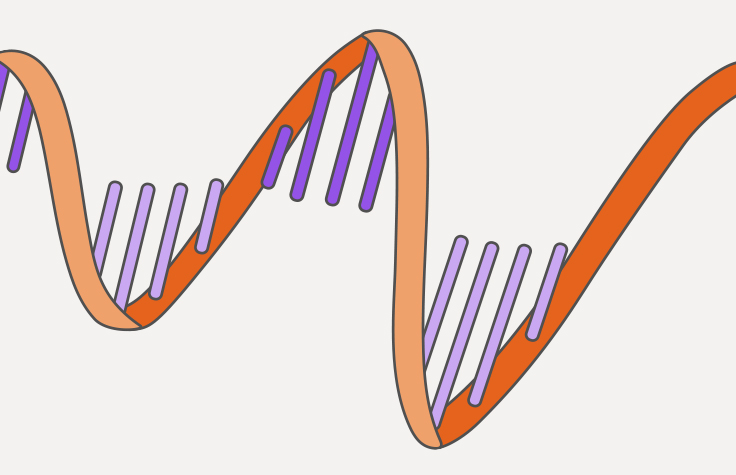RNA-Seq and Microarray Technology Comparison
RNA sequencing vs microarrays
RNA-Seq technology generates an unbiased view of the transcriptome, and offers a number of advantages compared to microarrays

RNA-Seq technology overview
RNA sequencing (RNA-Seq) technology enables rapid profiling and deep investigation of the transcriptome, for any species. This approach offers a number of advantages compared to microarray analysis, a legacy technology often used in gene expression studies.
Benefits of RNA-Seq vs microarrays
- Ability to detect novel transcripts: Unlike arrays, RNA-Seq technology does not require species- or transcript-specific probes. It can detect novel transcripts, gene fusions, single nucleotide variants, indels (small insertions and deletions), and other previously unknown changes that arrays cannot detect.1,2
- Wider dynamic range: With array hybridization technology, gene expression measurement is limited by background at the low end and signal saturation at the high end. RNA-Seq technology produces discrete, digital sequencing read counts, and can quantify expression across a larger dynamic range (> 105 for RNA-Seq vs 103 for arrays).1,2,3
- Higher specificity and sensitivity: Compared to microarrays, RNA-Seq technology can detect a higher percentage of differentially expressed genes, especially genes with low expression.4-6
- Simple detection of rare and low-abundance transcripts: Sequencing coverage depth can easily be increased to detect rare transcripts, single transcripts per cell, or weakly expressed genes.
How to start your first RNA-Seq project
Many researchers start their NGS journey with RNA sequencing, which provides insight into gene expression levels across sample types. This video provides a high-level overview of the RNA sequencing workflow.
"mRNA-Seq offers improved specificity, so it’s better at detecting transcripts, and specifically isoforms, than microarrays. It’s also more sensitive in detecting differential expression and offers increased dynamic range."
Illumina total RNA-Seq workflow video
This animated video takes you through the Illumina total RNA sequencing workflow covering the advantages of RNA-Seq over other RNA analysis methods, such as qPCR and gene expression arrays. Discover why RNA-Seq is a powerful sequencing method for visibility into previously undetectable changes in gene expression.
More reasons to switch from arrays to RNA-Seq
If NGS is a good fit for you, the next steps are to consider which applications and methods you’d like to perform, and choose an instrument that matches your expected output and application needs.
User-friendly data analysis tools
Thanks to its scale and unbiased discovery power, researchers can use NGS in a variety of basic and translational research areas. By providing a deeper view into a variety of biological systems using diverse sample types, you can expand the scope of your studies and find the answers to your boldest research applications.
RNA-Seq grants outpace array grants
The portion of NIH grant funding allocated to new RNA sequencing vs gene expression microarray-inclusive grants has been trending towards RNA-Seq technology for the last several years. Publication trends demonstrate the rapid adoption and increasing impact of RNA-Seq–based research.
RNA sequencing webinar series

RNA Sequencing Part I: Introduction to Illumina RNA library preparation workflows
This video covers key considerations for experiment planning and sample preparation kit options for RNA input.

RNA Sequencing Part II: Best Practices for Illumina RNA prep protocols
In the second part of our RNA-Seq video webinar series, we dive into best practices for Illumina RNA kits.

RNA Sequencing Part III: Introduction to Analysis
In this webinar, we discuss the user-friendly RNA-Seq analysis options available on BaseSpace, a data management and data analysis hub.
Additional resources

New to NGS eBook
For an in-depth look at NGS compared to to other methods, download our Getting Started with NGS eBook. This eBook outlines key differences, recommended methods/applications, sample workflows, and more.

Gene Expression and Regulation eBook
This eBook highlights discoveries powered by modern transcriptomics and epigenetics methods that are impacting our understanding of biology and disease.

Getting started with RNA-Seq
Transcriptomics, the characterization of the complete set or a designated subset of RNA transcripts produced by the genome, is an accessible entry point for using NGS, given its versatility across use cases and well-established workflows.
Related content
Benchtop sequencers
Benchtop sequencers are a popular way of getting started with NGS. This resource is a great place to learn about benchtop sequencing capabilities, instruments, and popular applications and methods for each.
Dynamic cancer transcriptome exposes new therapeutic targets
Sequencing RNA as well as DNA is giving researchers an extra dimension of information, and pointing oncologists towards potential avenues for treatment.
RNA library preparation
Find simple, customized RNA-Seq workflows and RNA kits for your experiment.
Have questions about bringing NGS into your lab?
If you have questions about NGS for your specific research focus, we’d love to help. Our specialists can answer any questions and recommend the best solution for your setup.
References
- Wang Z, Gerstein M, Snyder M. RNA-Seq: a revolutionary tool for transcriptomics. Nat Rev Genet. 2009;10:57–63.
- Wilhelm BT, Landry JR. RNA-Seq—quantitative measurement of expression through massively parallel RNA sequencing. Methods. 2009;48:249–57.
- Zhao S, Fung-Leung WP, Bittner A, and Ngo K, Liu X. Comparison of RNA-Seq and microarray in transcriptome profiling of activated T cells. PLoS One. 2014;16;9(1):e78644.
- Wang C, Gong B, Bushel PR, et al. The concordance between RNA-seq and microarray data depends on chemical treatment and transcript abundance. Nat Biotechnol. 2014;32:926–932.
- Li J, Hou R, Niu X, et al. Comparison of microarray and RNA-Seq analysis of mRNA expression in dermal mesenchymal stem cells. Biotechnol Lett. 2016;38:33–41.
- Liu Y, Morley M, Brandimarto J, et al. RNA-Seq identifies novel myocardial gene expression signatures of heart failure. Genomics. 2015;105:83–89.

